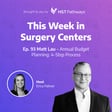
Erica Palmer – Improving Patient Collections: Post-Date of Service
Welcome back to our three-part series on Improving Patient Collections! In our last episode, we were joined by Sayword Hill from Constitution, who shared expert insights on mastering eligibility. This week, while we had originally planned to bring you another guest to dive into post-date of service (DOS) collections, plans shifted due to Hurricane Milton. So, it's just me, Erica Palmer, taking the mic solo to share actionable tips for boosting patient collections after your patients are discharged.
This episode couldn’t have come at a better time! HST recently released our State of the Industry Report, packed with valuable data, including insights on outstanding post-DOS patient bills. I’ll be weaving that data into today's episode as I break down key strategies to improve your collections process and maximize your revenue.
Resources Mentioned:
HST’s 2024 State of the Industry Report
Brought to you by HST Pathways.



















